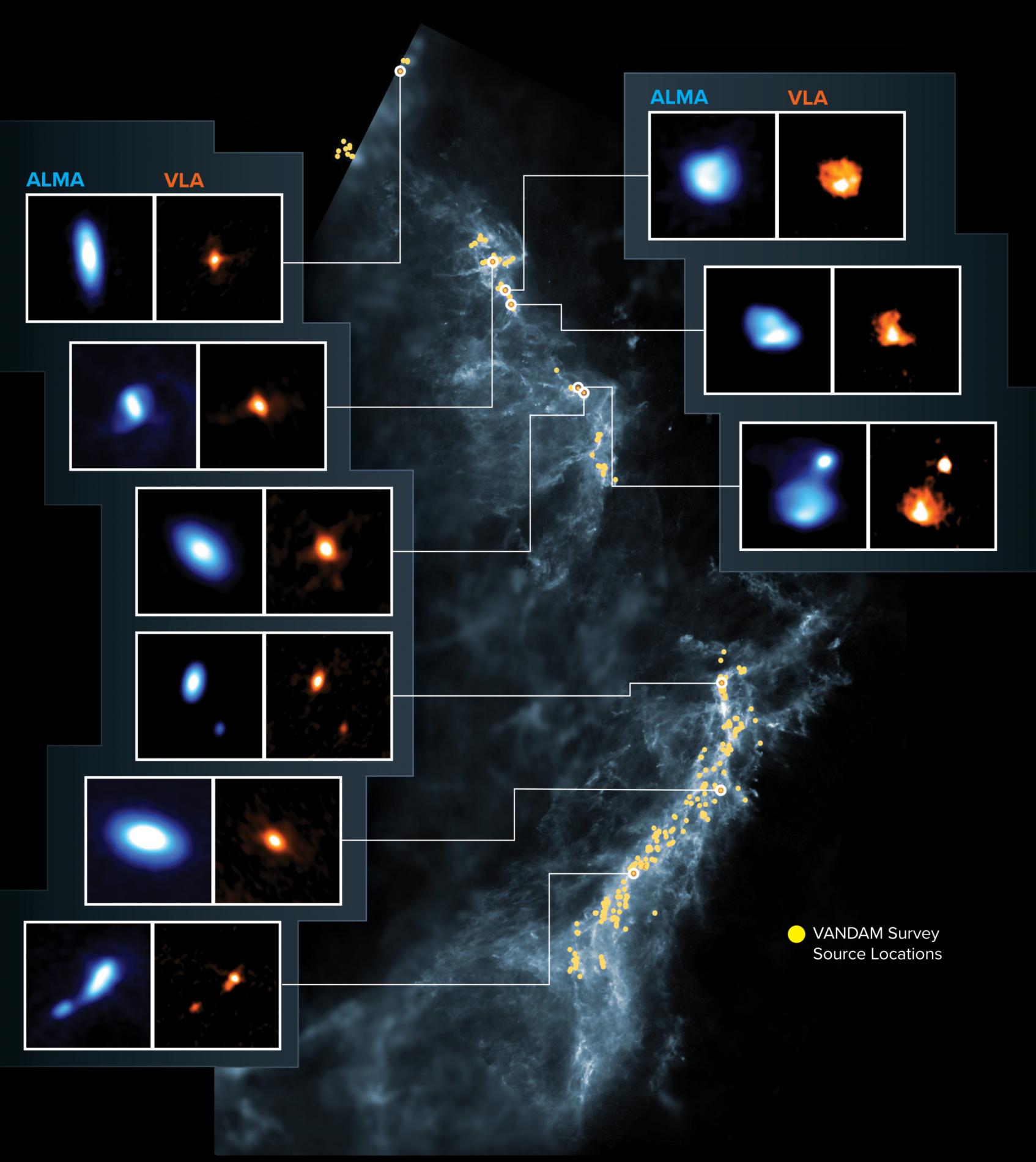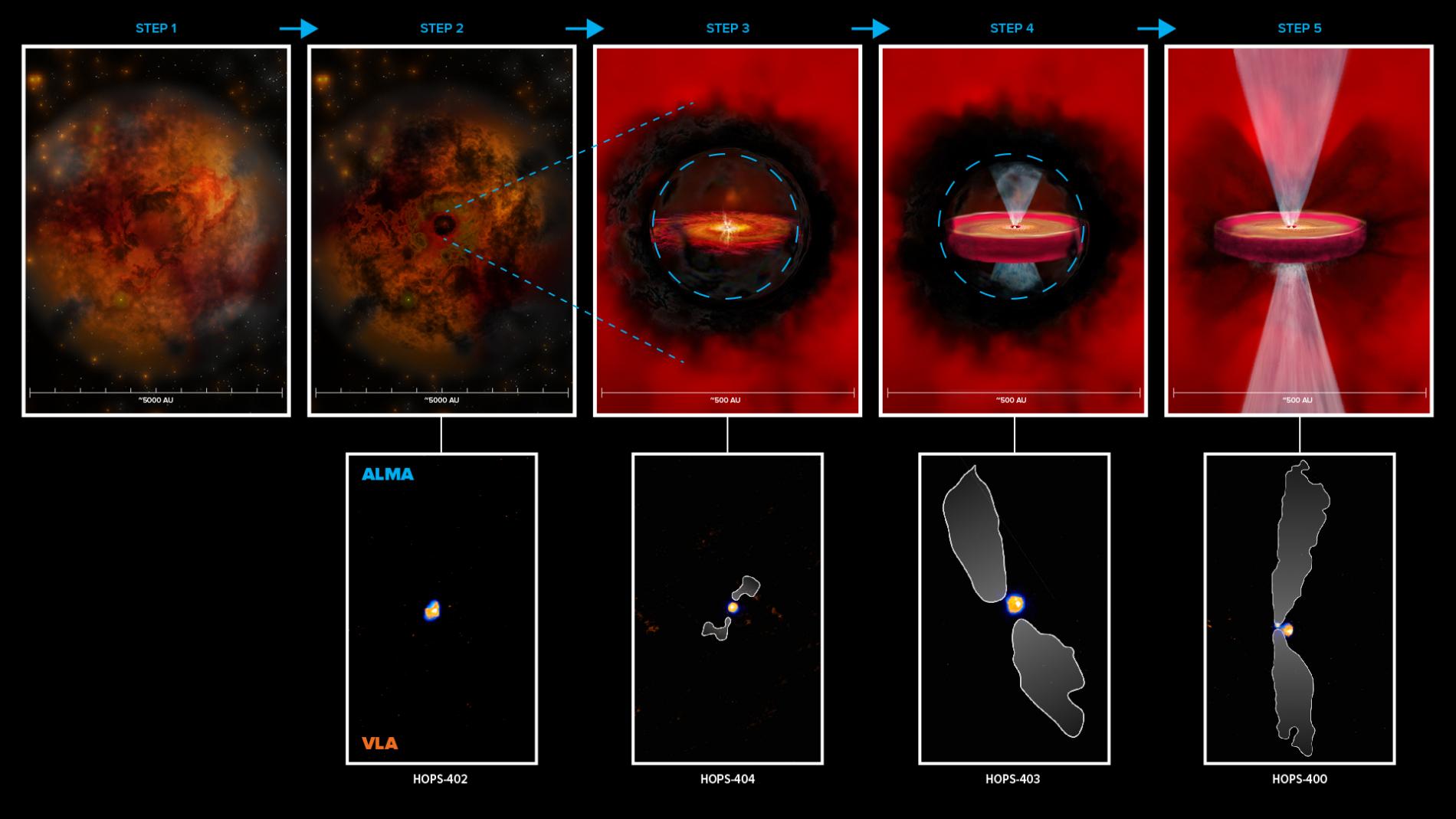More than three hundred planet-forming disks around young stars found in the Orion Clouds
ALMA and VLA radiotelescopes enter the Orion Clouds, a stellar nursery that reveals how newborn stars evolve and develop protoplanetary discs. Researchers from the Institute of Astrophysics of Andalusia (IAA-CSIC) participate in the work, which constitutes the largest survey of this type performed to date
Stars form in molecular clouds, huge clouds of gas (with a small percentage of the dust) that can contain enough mass to generate thousands, even millions, of stars like the Sun. The embryos of future stars are hidden inside these clouds, making observation of the process of star formation, as well as the disks from which the planets are born, difficult. Now, an international team of astronomers has completed the largest survey of newborn stars developed to date, with more than three hundred protoplanetary disks discovered.
HOW STARS FORM
According to star formation models, star birth begins with the fragmentation of the cloud. Each fragment will undergo a slow process of contraction until the stellar embryo, or protostar, is formed and grows by accumulating material through a rotating disk around it. Simultaneously, the star ejects the remaining material along its polar axis in the form of a powerful jet, which stabilizes its rotation and allows it to continue growing.
However, these first stages of star formation still have unknowns. "Thanks to powerful instruments such as ALMA (Atacama Large Millimeter/submillimeter Array) and VLA (Very Large Array) radiotelescopes, we can observe increasingly earlier stages in the process of star formation, when powerful ejections of matter still coexist with the development of disks around them, which constitute the seeds of possible planetary systems", says Ana Karla Díaz-Rodríguez, a researcher at the Institute of Astrophysics of Andalusia who participates in the work.

"These results, with the detection of hundreds of planetary systems in the Orion clouds, illustrate very well the diversity of physical conditions in which this process can occur. Orion is a region rich in young stars, where high and low mass protostars coexist, and whose formation takes place both in isolation and in groups, so its study is of great relevance to this field", says Mayra Osorio, IAA-CSIC researcher who participates in the result.
The sample obtained has made it possible, for example, to compare the mass and average size of young protoplanetary disks with those in a more advanced evolutionary state. The researchers have found that, although they all show a similar size, the young disks are much more massive, which suggests that the larger planets are formed in very early stages of star formation.
PECULIAR PROTOSTARS
Among the hundreds of images in the survey, four objects stand out. They are irregular and "lumpy" in shape and are opaque even to radio waves, which could be an indication that they are in an earlier stage than the protostar.
To be defined as a typical protostar, stars must not only have a flat disk around them, but also the bipolar jet that releases material, but it is not yet known at what point in the star's formation the jet is generated.

For example, one of the stars in the study, HOPS 404, shows a flow of material moving at two kilometres per second, when the typical speed in these structures is between ten and one hundred kilometres per second. "We are looking at a large, swollen sun that is still accumulating mass, but has just begun to expel matter in order to lose angular momentum and continue to grow", says Nicole Karnath, a researcher at the University of Toledo (Ohio, USA) who heads one of the two articles published. This is one of the smallest flows we have seen, and it is presented as one of the first stages in the formation of a protostar".
These four objects are a rarity, and although researchers cannot confirm their age, they estimate that they are less than ten thousand years old. For stars like the Sun, the process of gravitational contraction is believed to end after ten million years, at which point the thermonuclear reactions that define a star itself begin. We are, therefore, looking at really young objects.
N. Karnath et al. "Detection of Irregular, Sub-mm Opaque Structures in the Orion Molecular Clouds: Protostars within 10000 years of formation?". The Astrophysical Journal.
J. J. Tobin et al. " The VLA/ALMA Nascent Disk and Multiplicity (VANDAM) Survey of Orion Protostars. A Statistical Characterization of Class 0 and I Protostellar Disks". The Astrophysical Journal. DOI:
Instituto de Astrofísica de Andalucía (IAA-CSIC)
Unidad de Divulgación y Comunicación
Silbia López de Lacalle - sll[arroba]iaa.es - 958230676
https://www.iaa.csic.es
https://divulgacion.iaa.csic.es

